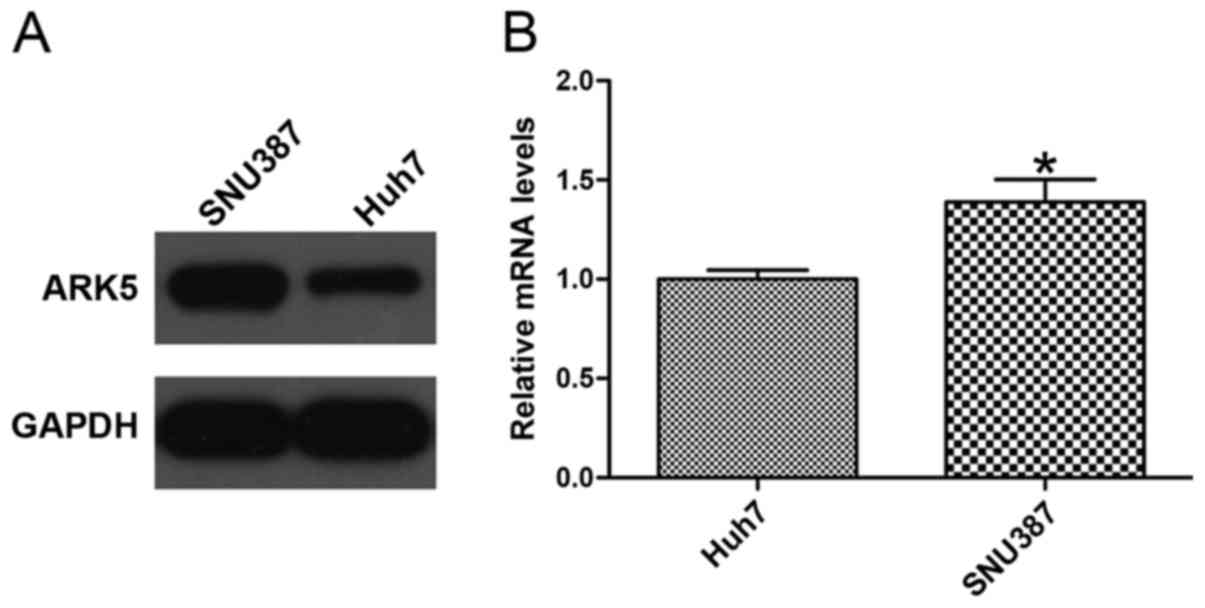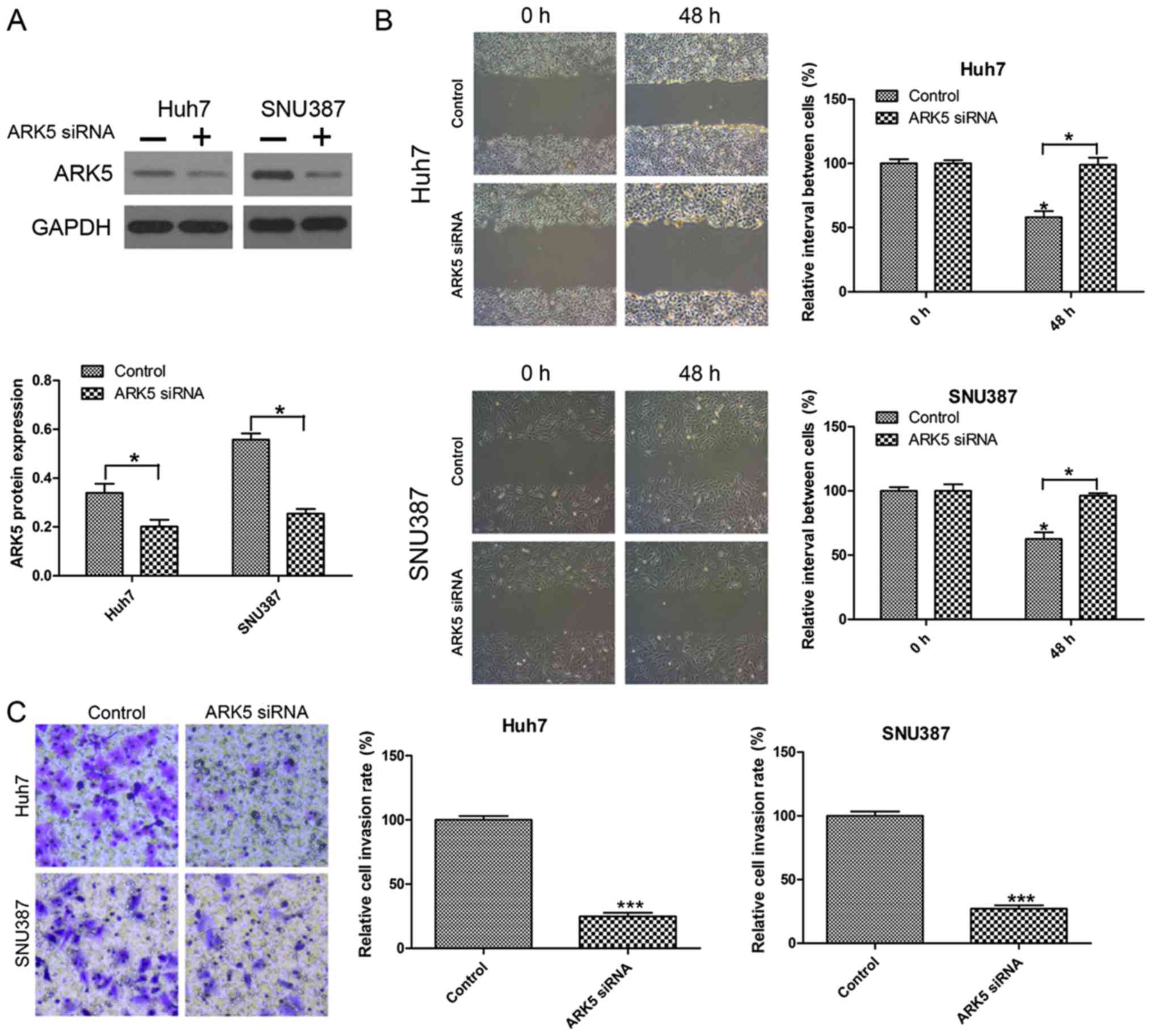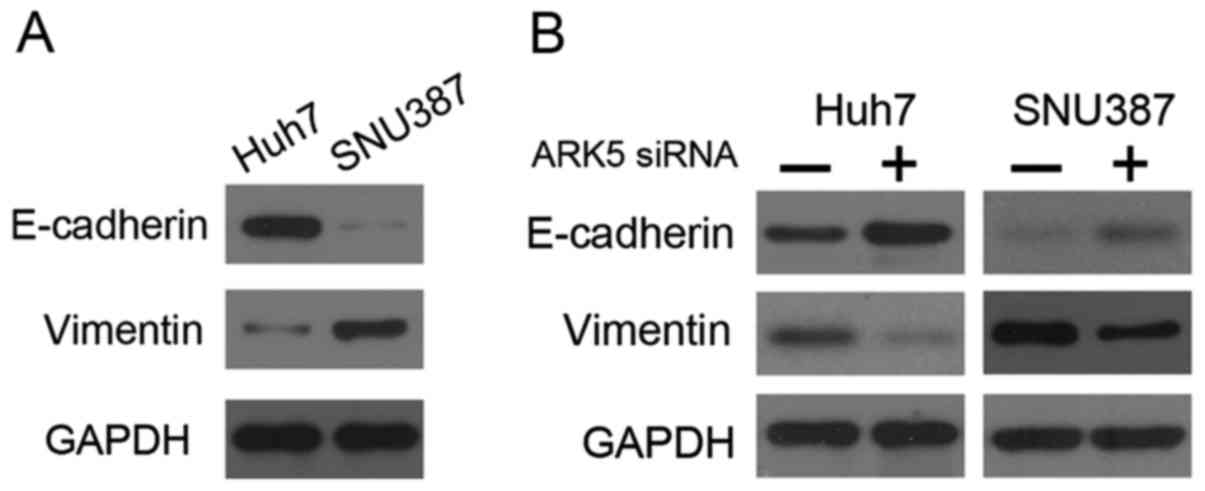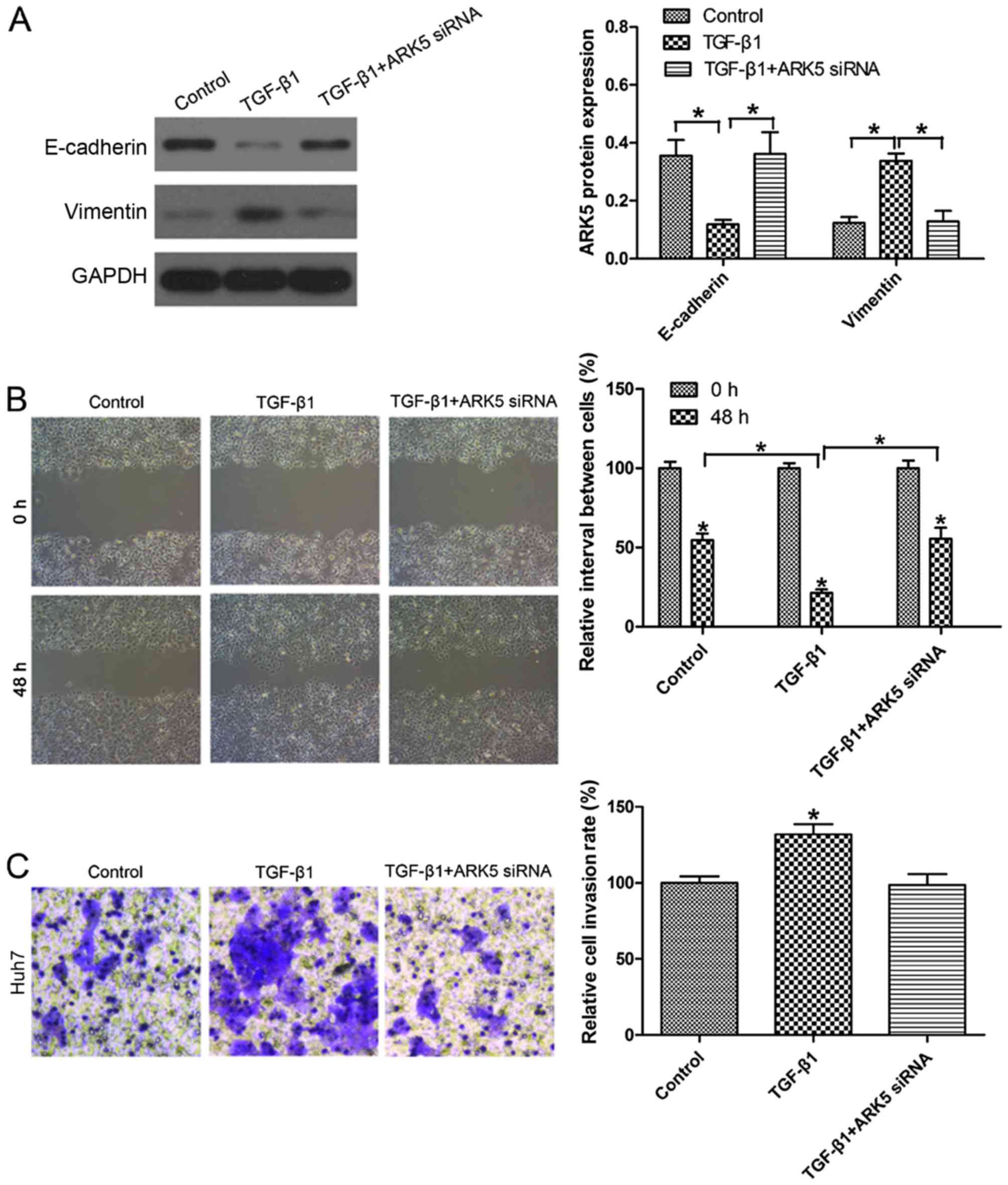ARK5 promotes invasion and migration in hepatocellular carcinoma cells by regulating epithelial-mesenchymal transition
- Authors:
- Published online on: November 21, 2017 https://doi.org/10.3892/ol.2017.7453
- Pages: 1511-1516
-
Copyright: © Ye et al. This is an open access article distributed under the terms of Creative Commons Attribution License.
Abstract
Introduction
Hepatocellular carcinoma (HCC) is a malignancy with one of the highest mortality rates, and it has been ranked as the fifth most common malignancy globally (1). Although substantial progress has been made in the diagnosis and treatment of HCC, it remains the third leading cause of cancer-associated mortality globally (2). Therefore, there is an urgent requirement to investigate the molecular mechanisms by which HCC progresses and to find novel diagnostic factors and effective therapeutic strategies to improve patient survival rates.
The epithelial-mesenchymal transition (EMT) comprises a complex series of reversible events that may lead to the loss of epithelial cell adhesion and the indication of a mesenchymal phenotype (3). EMT serves crucial roles during embryonic development, tumor metastasis and invasion, and is one of the major molecular mechanisms through which invasion and metastasis are promoted during the oncogenic process (4,5). Previous studies demonstrated that EMT activation in cancer cells contributed to tumor invasion and metastasis in various types of cancer, including HCC, resulting in aggressive cancer progression (6,7). Taken together, these findings indicate that EMT is associated with metastasis.
AMPK-related protein kinase 5 (ARK5) is a member of the human AMP-activated protein kinase family. ARK5 was identified as a key molecule in mediating the migration of cancer cells in human pancreatic cancer cells, and its activation was induced by Akt-dependent Ser600 phosphorylation (8). It has been reported that the overexpression of ARK5 was involved in tumor progression and metastatic activity in colorectal cancer (9). Tumor malignancy, including invasion and metastasis, is accelerated by the activation of Akt, a process that has been demonstrated for breast, ovarian, colorectal and pancreatic cancer, and squamous cell carcinoma (10–13). ARK5 was reported to promote invasion and metastasis in cancer cells, including breast cancer, colorectal cancer and glioma (9,14,15). However, the mechanism by which ARK5 alters invasion and metastasis has not been fully identified in HCC cells.
In the present study, the authors hypothesized that ARK5 may be involved in HCC cell invasion and metastasis through EMT. Suppression of ARK5 may be used as a potential target for the treatment of HCC. To investigate this hypothesis, the role of ARK5 in invasion and metastasis of cancer was investigated using HCC cells.
Materials and methods
Cell culture
The human HCC Huh7 and SNU387 cells were purchased from the American Type Culture Collection (Manassas, VA, USA). Huh7 cells were cultured in Dulbecco's Modified Eagle's Medium (DMEM; Gibco; Thermo Fisher Scientific, Inc., Waltham, MA, USA) containing 10% fetal bovine serum (FBS; Gibco; Thermo Fisher Scientific, Inc.) and 1% penicillin/streptomycin (Sigma-Aldrich; Merck KGaA, Darmstadt, Germany). SNU387 cells were maintained in RPMI-1640 medium (Gibco; Thermo Fisher Scientific, Inc.) supplemented with 10% FBS and 1% penicillin/streptomycin. All cells were grown in a humidified incubator at 37°C and with 5% CO2.
Short interfering RNA (siRNA) transfection
HCC Huh7 and SNU387 cells were transfected with 100 nmol/l ARK5 siRNA (Santa Cruz Biotechnology, Inc., Dallas, TX, USA) or negative siRNA control (Invitrogen; Thermo Fisher Scientific, Inc.) using Lipofectamine® 2000 (Invitrogen; Thermo Fisher Scientific, Inc.) following the manufacturer's protocol. The transfection medium Opti-MEM (Gibco; Thermo Fisher Scientific, Inc.) was used. After 6 h, the transfection medium was removed, and the cells were maintained in DMEM and RPMI-1640 medium for an additional 24 h, at which point all subsequent experiments were performed.
Western blot analysis
HCC Huh7 and SNU387 cells were washed with cold phosphate-buffered saline (PBS) and treated with cell lysis buffer (Cell Signaling Technology, Inc., Danvers, MA, USA) at 4°C or on ice for 2 h. The concentration of the proteins was measured using BCA Protein Assay kit (Pierce; Thermo Fisher Scientific, Inc.). The protein (40 µg per lane) were separated by 10% SDS-PAGE and transferred onto polyvinylidene difluoride membranes (EMD Millipore, Billerica, MA, USA). The membranes were then blocked with 5% bovine serum albumin (Sangon Biotech Co., Ltd., Shanghai, China) in 0.1% Tween-20 (TBS/T) and incubated with primary antibodies against ARK5 (cat no. ab71814), E-cadherin (cat no. ab76055) and vimentin (cat no. ab8978) (all 1:1,000; Abcam, Cambridge, MA, USA) at 4°C overnight. The membranes were then washed three times with TBST and then incubated with the appropriate secondary antibody (1:2,000, Santa Cruz Biotechnology, Inc., Dallas, TX, USA) at 37°C for 2 h. The protein bands were visualized by chemiluminesence using an enhanced chemiluminesence kit (GE Healthcare, Piscataway, NJ, USA) and were quantified by densitometry using Image Lab 5.0 software (Bio-Rad Laboratories, Inc., Hercules, CA, USA). GAPDH (1:2,000; Cell Signaling Technology, Inc.; cat no. 5174) was used as an internal control.
Reverse transcription-quantitative polymerase chain reaction (RT-qPCR) analysis
Total RNA was extracted from HCC Huh7 and SNU387 cells with TRIzol (Invitrogen, Carlsbad, CA, USA). cDNA was synthesized using M-MLV Reverse Transcript reagent (Invitrogen; Thermo Fisher Scientific, Inc.) according to the manufacturer's protocol. qPCR was performed using SYBR Green PCR kit (Takara Bio, Inc., Otsu, Japan) and analyzed using an ABI Prism 7500 Real-time PCR system (Applied Biosystems, CA, USA) under the following reaction conditions: 50°C for 2 min; 95°C for 30 sec and followed by 40 cycles of 60°C for 30 sec. All reactions were performed in triplicate. ARK5 mRNA expression was quantified and reported as 2−ΔΔCq (16). The expression level of each gene was normalized to the expression level of GAPDH. The primers were as follows: ARK forward, 5′-GAGTCCACTCTATGCATC-3′ and reverse, 5′-GGCCACTATTGAGGACA-3′.
Wound-healing assay
HCC Huh7 and SNU387 cells were seeded into 6-well plates at a density of 3×105 cells/well and cultured in the appropriate medium (DMEM used for Huh7 cells, and RPMI-1640 used for SNU387 cells) containing 10% FBS, 1% penicillin/streptomycin at 37°C with 5% CO2 for 24 h until 90% confluence, and then the medium was changed to the corresponding medium (DMEM used for Huh7 cells, and RPMI-1640 used for SNU387 cells) containing 0.05% FBS, 1% penicillin/streptomycin overnight to synchronize the cells. The cells were wounded with 100 µl pipette tips, and the cell debris was washed away with PBS. The wound scars were photographed with an inverted light microscope at 0 and 24 h after the scratch was made. The ratio of the remaining wound area relative to the initial wound area was calculated, and the wound area was quantified using Image-Pro Plus software (version 6.0; Media Cybernetics, Inc., Rockville, MD, USA).
Transwell Matrigel invasion assay
The Huh7 and SNU387 cells were seeded at a density of 5×104 cells/well in the upper chamber of a Transwell 24-insert plate with corresponding medium (DMEM used for Huh7 cells, and RPMI-1640 used for SNU387 cells). Following transfection with ARK5 siRNA (100 nmol/ml) for 6 h, the cells were treated with TGF-β1 (10 ng/ml) for 48 h. The upper chambers were coated with Matrigel (BD Biosciences, San Jose, CA, USA), and the lower chamber contained the same medium supplemented with 10% FBS. After 24 h, the bottom of the inserts were fixed in methanol for 10 min and stained with H&E for 3 min at 37°C. The cells that had invaded to the lower surface were counted using an inverted phase-contrast microscope (magnification, 40x) and images were captured.
Statistical analysis
All data are expressed as the mean ± standard deviation. Statistical analysis was performed using one-way analysis of variance (ANOVA) followed by Tukey's post hoc test. Student's t-test was also used. GraphPad Prism (version 5.0; GraphPad Software, Inc., La Jolla, CA, USA) was used to perform all statistical analysis. P<0.05 was considered to indicate a statistically significant difference. All experiments were performed at least three times as independent experiments.
Results
ARK5 expression level is different between Huh7 and SNU387 cell lines
To confirm whether the expression level of ARK5 was associated with HCC cell lines, western blotting and RT-qPCR were used to analyze the expression of ARK5. The HCC Huh7 cell line, with an epithelial phenotype, exhibited low expression of ARK5, whereas the mesenchymal phenotype HCC SNU387 cell line exhibited high expression of ARK5 (Fig. 1), indicating that the level of ARK5 may be associated with invasion and migration in HCC cells (P<0.05 vs. Huh7).
Knockdown of ARK5 inhibits invasion and migration in Huh7 and SNU387 cells
To investigate the function of ARK5 in invasion and migration in HCC cells, the effect of ARK5 knockdown on metastasis was investigated by Transwell invasion and wound healing migration assays. The knockdown efficiency was examined by western blot analysis (Fig. 2A). The results indicated that inhibiting the expression of ARK5 was able to significantly reduce cell migration compared with the control under normal conditions after 24 h in wound healing migration assays (Fig. 2B). In the Transwell invasion assay, it was observed that the number of HCC cells transfected with ARK5 siRNA passed through the Transwell membranes were decreased compared with the control group (Fig. 2C).
Knockdown of ARK5 may upregulate the expression of E-cadherin and downregulate vimentin expression in HCC cells
It has been reported that EMT serves a notable role in the development of drug resistance in a number of different tumor types, including cancer of the breast, lung, colon, and pancreas, with tumor cells that have gained drug resistance displaying a higher degree of malignant, and migratory and invasive ability (17–20). Studies have demonstrated that the inhibition of ARK5 results in the upregulation of E-cadherin expression and downregulation of vimentin expression in HCC, ovarian cancer and non-small lung cancer cells (21–23). In the present study, western blot analysis revealed that Huh7 cells exhibited high E-cadherin expression and low vimentin expression, whereas SNU387 cells exhibited the opposite pattern of expression (Fig. 3A). The results of the present study also demonstrated that siRNA-mediated silencing of ARK5 resulted in upregulation of E-cadherin and downregulation of vimentin in Huh7 and SNU387 cells (Fig. 3B). These results demonstrated that the inhibition of ARK5 may reverse EMT.
Inhibition of ARK5 reverses EMT under TGF-β1 treatment in Hep3B cells
Previously, TGF-β1 has been identified as the key driver in inducing EMT (24). Following exposure to 10 ng/ml TGF-β1 for 48 h, E-cadherin expression in Huh7 cells was markedly decreased. Notably, the expression of E-cadherin in Huh7 cells was upregulated upon transfection with ARK5 siRNA following TGF-β1 treatment compared with TGF-β1-treated cells (Fig. 4A). Wound healing assays revealed that the knockdown of ARK5 was able to reverse TGF-β1-induced cell migratory ability (Fig. 4B). Transwell invasion assays also revealed that the knockdown of ARK5 was able to reverse TGF-β1-induced invasion (Fig. 4C). There was no significant difference between the group transfected with AKR5 siRNA combined with TGF-β1 and the control in Huh7 cells. These findings indicated that the knockdown of ARK5 may reverse TGF-β1-induced EMT and reduce the invasive and metastatic capabilities of Huh7 cells, which have an epithelial phenotype.
Discussion
There is a high mortality associated with HCC, the fifth most common tumor worldwide, due to a lack of effective treatments (25). HCC is frequently diagnosed at an advanced stage and thus is associated with poor prognosis (26). It is known that cell invasion is essential for tumor metastasis, and Akt has been identified to serve a key role in invasion and metastasis of tumor cells (27–29). Therefore, it is important to understand the molecular basis of the involvement of ARK5 in the invasion and metastasis of HCC cell lines.
Evidence indicates that EMT serves a key role in carcinogenicity, metastasis, progression and acquired chemoresistance in many types of cancer, including in HCC (30,31). During EMT, expression of the epithelial marker E-cadherin decreases, whereas that of the mesenchymal marker vimentin increases (32). ARK5 is a tumor invasion-associated factor that is downstream of Akt signaling. Cancer cells with high ARK5 expression exhibit high invasive activity (11). It has been demonstrated that the inhibition of ARK5 is able to enhance drug sensitivity in hepatocellular carcinoma through EMT (21). However, prior to the present study, there were a limited number of reports concerning the role of ARK5 in the metastasis of other cancer types (14,33), including HCC.
The results of the present study indicated that the knockdown of ARK5 markedly decreased migration and invasion of HCC cells. Furthermore, the inhibition of ARK5 was also able to increase the expression of the epithelial marker E-cadherin and reduce expression of the mesenchymal marker vimentin in Huh7 and SNU387 cells, compared with the control.
TGF-β1 is a pleiotropic cytokine that regulates cell proliferation and differentiation (34). TGF-β1 induces a mesenchymal phenotype and functions as a tumor suppressor that restricts cell growth, resulting in the inhibition of cancer progression during the early stages of carcinogenesis (35). However, as cancer progresses, TGF-β1 becomes a tumor promoter, performing dual roles in the progression and metastasis of HCC (36–38). The data reported in the present study indicated that TGF-β treatment of HCC cells was able to induce invasion and migration. When the epithelial Huh7 cells were treated with TGF-β1, the invasive capability and migratory rate of these cells was increased compared with the control. Notably, this increased invasive capability and migratory rate was reversed upon ARK5 knockdown and treatment with TGF-β1, suggesting that ARK5 may reduce invasion and migration in HCC cells. Furthermore, these data also indicated that the treatment of Huh7 cells with TGF-β1 resulted in decreased E-cadherin expression and increased expression of vimentin compared with the control. However, the downregulation of ARK5 was able to reverse TGF-β1-induced EMT in Huh7 cells. These results indicated that the expression of ARK5 may serve an important role in cellular invasion and metastasis and EMT phenotype changes of HCC cells.
In summary, the present study demonstrated that inhibiting the expression of ARK5 may reduce the ability of the HCC cells to invade and metastasize via EMT. Therefore, ARK5 has the potential to be a molecular target for the development of novel therapy of HCC, which focuses on cell invasion.
References
|
Waly Raphael S, Yangde Z and Yuxiang C: Hepatocellular carcinoma: Focus on different aspects of management. ISRN Oncol. 2012:4216732012.PubMed/NCBI | |
|
Siegel RL, Miller KD and Jemal A: Cancer statistic, 2015. CA Cancer J Clin. 65:5–29. 2015. View Article : Google Scholar : PubMed/NCBI | |
|
Thiery JP and Sleeman JP: Complex networks orchestrate epithelial-mesenchymal transitions. Nat Rev Mol Cell Biol. 7:131–142. 2006. View Article : Google Scholar : PubMed/NCBI | |
|
Thiery JP, Acloque H, Huang RY and Nieto MA: Epithelial-mesenchymal transitions in development and disease. Cell. 139:871–890. 2009. View Article : Google Scholar : PubMed/NCBI | |
|
Kaufhold S and Bonavida B: Central role of Snail1 in the regulation of EMT and resistance in cancer: A target for therapeutic intervention. J Exp Clin Cancer Res. 33:622014. View Article : Google Scholar : PubMed/NCBI | |
|
Christiansen JJ and Rajasekaran AK: Reassessing epithelial to mesenchymal transition as a prerequisite for carcinoma invasion and metastasis. Cancer Res. 66:8319–8326. 2006. View Article : Google Scholar : PubMed/NCBI | |
|
Lee TK, Poon RT, Yuen AP, Ling MT, Kwok WK, Wang XH, Wong YC, Guan XY, Man K, Chau KL and Fan ST: Twist overexpression correlates with hepatocellular carcinoma metastasis through induction of epithelialmesenchymal transition. Clin Cancer Res. 12:5369–5376. 2006. View Article : Google Scholar : PubMed/NCBI | |
|
Suzuki A, Kusakai G, Kishimoto A, Lu J, Ogura T, Lavin MF and Esumi H: IdentiWcation of a novel protein kinase mediating Akt survival signaling to the ATM protein. J Biol Chem. 278:48–53. 2003. View Article : Google Scholar : PubMed/NCBI | |
|
Kusakai G, Suzuki A, Ogura T, Miyamoto S, Ochiai A, Kaminishi M and Esumi H: ARK5 expression in colorectal cancer and its implications for tumor progression. Am J Pathol. 164:987–995. 2004. View Article : Google Scholar : PubMed/NCBI | |
|
Ekstrand AI, Jonsson M, Lindblom A, Borg A and Nilbert M: Frequent alterations of the PI3K/AKT/mTOR pathways in hereditary nonpolyposis colorectal cancer. Fam Cancer. 9:125–129. 2010. View Article : Google Scholar : PubMed/NCBI | |
|
Li B, Tsao SW, Li YY, Wang X, Ling MT, Wong YC, He QY and Cheung AL: Id-1 promotes tumorigenicity and metastasis of human esophageal cancer cells through activation of PI3K/AKT signaling pathway. Int J Cancer. 125:2576–2585. 2009. View Article : Google Scholar : PubMed/NCBI | |
|
Ohta T, Isobe M, Takahashi T, Saitoh-Sekiguchi M, Motoyama T and Kurachi H: The Akt and ERK activation by platinum-based chemotherapy in ovarian cancer is associated with favorable patient outcome. Anticancer Res. 29:4639–4647. 2009.PubMed/NCBI | |
|
Simon PO Jr, McDunn JE, Kashiwagi H, Chang K, Goedegebuure PS, Hotchkiss RS and Hawkins WG: Targeting AKT and with the proapoptotic peptide, TAT-CTMP: A novel strategy for the treatment of human pancreatic adenocarcinoma. Int J Cancer. 125:942–951. 2009. View Article : Google Scholar : PubMed/NCBI | |
|
Chang XZ, Yu J, Liu HY, Dong RH and Cao XC: ARK5 is associated with the invasive and metastatic potential of human breast cancercells. J Cancer Res Clin Oncol. 138:247–254. 2012. View Article : Google Scholar : PubMed/NCBI | |
|
Lu S, Niu N, Guo H, Tang J, Guo W, Liu Z, Shi L, Sun T, Zhou F, Li H, Zhang J and Zhang B: ARK5 promotes glioma cell invasion, andits elevated expression is correlated with poorclinical outcome. Eur J Cancer. 49:752–763. 2013. View Article : Google Scholar : PubMed/NCBI | |
|
Bustin SA: Absolute quantification of mRNA using real-time reverse transcription polymerase chain reaction assays. J Mol Endocrinol. 25:169–193. 2000. View Article : Google Scholar : PubMed/NCBI | |
|
Zheng X, Carstens JL, Kim J, Scheible M, Kaye J, Sugimoto H, Wu CC, LeBleu VS and Kalluri R: Epithelialto-mesenchymal transition is dispensable for metastasis but induces chemoresistance in pancreatic cancer. Nature. 527:525–530. 2015. View Article : Google Scholar : PubMed/NCBI | |
|
Liu Y, DU F, Zhao Q, Jin J, Ma X and Li H: Acquisition of 5-fluorouracil resistanceinduces epithelial-mesenchymal transitions through the Hedgehog signaling pathway in HCT-8 colon cancer cells. Oncol Lett. 9:2675–2679. 2015.PubMed/NCBI | |
|
Fischer KR, Durrans A, Lee S, Sheng J, Li F, Wong ST, Choi H, El Rayes T, Ryu S, Troeger J, et al: Epithelial-to-mesenchymal transition is not required for lung metastasis but contributes tochemoresistance. Natur. 527:472–476. 2015. View Article : Google Scholar | |
|
Mallini P, Lennard T, Kirby J and Meeson A: Epithelial-to-mesenchymal transition: What is the impact on breast cancer stem cells and drug resistance. Cancer Treat Rev. 40:341–348. 2014. View Article : Google Scholar : PubMed/NCBI | |
|
Xu T, Zhang J, Chen W, Pan S, Zhi X, Wen L, Zhou Y, Chen BW, Qiu J, Zhang Y, et al: ARK5 promotes doxorubicin resistance in hepatocellular carcinoma via epithelial-mesenchymal transition. Cancer Lett. 377:140–148. 2016. View Article : Google Scholar : PubMed/NCBI | |
|
Zhang HY, Li JH, Li G and Wang SR: Activation of ARK5/miR-1181/HOXA10 axis promotes epithelial-mesenchymal transition in ovarian cancer. Oncol Rep. 34:1193–1202. 2015. View Article : Google Scholar : PubMed/NCBI | |
|
Li M, Zheng C, Xu H, He W, Ruan Y, Ma J, Zheng J, Ye C and Li W: Inhibition of AMPK-related kinase 5 (ARK5) enhances cisplatin cytotoxicity in non-small cell lung cancer cells through regulation of epithelial-mesenchymal transition. Am J Transl Res. 9:1708–1719. 2017.PubMed/NCBI | |
|
Park NR, Cha JH, Jang JW, Bae SH, Jang B, Kim JH, Hur W, Choi JY and Yoon SK: Synergistic effects of CD44 and TGF-β1 through AKT/GSK-3β/β-catenin signaling during epithelial-mesenchymal transition in liver cancer cells. Biochem Biophys Res Commun. 477:568–574. 2016. View Article : Google Scholar : PubMed/NCBI | |
|
El-Serag HB: Hepatocellular carcinoma. N Engl J Med. 365:1118–1127. 2011. View Article : Google Scholar : PubMed/NCBI | |
|
Kanda M, Sugimoto H and Kodera Y: Genetic and epigenetic aspects of initiation and progression of hepatocellular carcinoma. World J Gastroenterol. 21:10584–10597. 2015. View Article : Google Scholar : PubMed/NCBI | |
|
Kawasaki K, Smith RS Jr, Hsieh CM, Sun J, Chao J and Liao JK: Activation of and the phosphatidylinositol 3-kinase/protein kinase Akt pathway mediates nitric oxide-induced endothelial cell migration and angiogenesis. Mol Cell Biol. 23:5726–5737. 2003. View Article : Google Scholar : PubMed/NCBI | |
|
Li G, Satyamoorthy K and Herlyn M: N-cadherin-mediated intercellular interactions promote survival and migration of melanoma cells. CancerRes. 61:3819–3825. 2001. | |
|
Liu W, Liu Y and Lowe WL Jr: The role of phosphatidylinositol 3-kinaseand the mitogen-activated protein kinases in insulin-like growth factor-I-mediated effects in vascular endothelial cells. Endocrinology. 142:1710–1719. 2001. View Article : Google Scholar : PubMed/NCBI | |
|
Choi SS and Diehl AM: Epithelial-to-mesenchymal transitions in the liver. Hepatology. 50:2007–2013. 2009. View Article : Google Scholar : PubMed/NCBI | |
|
Xia H, Ooi LL and Hui KM: MicroRNA-216a/217-induced epithelial-mesenchymal transition targets PTEN and SMAD7 to promote drug resistance and recurrenceof liver cancer. Hepatology. 58:629–641. 2013. View Article : Google Scholar : PubMed/NCBI | |
|
Thomson S, Petti F, Sujka-Kwok I, Mercado P, Bean J, Monaghan M, Seymour SL, Argast GM, Epstein DM and Haley JD: A systems view of epithelial-mesenchymal transition signaling states. Clin Exp Metastasis. 28:137–155. 2011. View Article : Google Scholar : PubMed/NCBI | |
|
Chen D, Liu G, Xu N, You X, Zhou H, Zhao X and Liu Q: Knockdown of ARK5 expression suppresses invasion and metastasis of gastric cancer. Cell Physiol Biochem. 42:1025–1036. 2017. View Article : Google Scholar : PubMed/NCBI | |
|
Chen XF, Zhang HJ, Wang HB, Zhu J, Zhou WY, Zhang H, Zhao MC, Su JM, Gao W, Zhang L, et al: Transforming growth factor-β1 induces epithelial-to mesenchymal transition in human lung cancer cells via PI3K/Akt and MEK/Erk1/2 signaling pathways. Mol Biol Rep. 39:3549–3556. 2012. View Article : Google Scholar : PubMed/NCBI | |
|
Xu Z, Shen MX, Ma DZ, Wang LY and Zha XL: TGF-beta1-promoted epithelial-to-mesenchymal transformation and cell adhesion contribute to TGF-beta1-enhanced cell migration in SMMC-7721 cells. Cell Res. 13:343–350. 2003. View Article : Google Scholar : PubMed/NCBI | |
|
Dang H, Ding W, Emerson D and Rountree CB: Snail1 induces epithelial-tomesenchymal transition and tumor initiating stem cell characteristics. BMC Cancer. 11:3962011. View Article : Google Scholar : PubMed/NCBI | |
|
Ji J and Wang XW: Clinical implications of cancer stem cell biology in hepatocellular carcinoma. Semin Oncol. 39:461–472. 2012. View Article : Google Scholar : PubMed/NCBI | |
|
Yang JD, Nakamura I and Roberts LR: The tumor microenvironment in hepatocellular carcinoma: Current status and therapeutic targets. Semin Cancer Biol. 21:35–43. 2011. View Article : Google Scholar : PubMed/NCBI |













